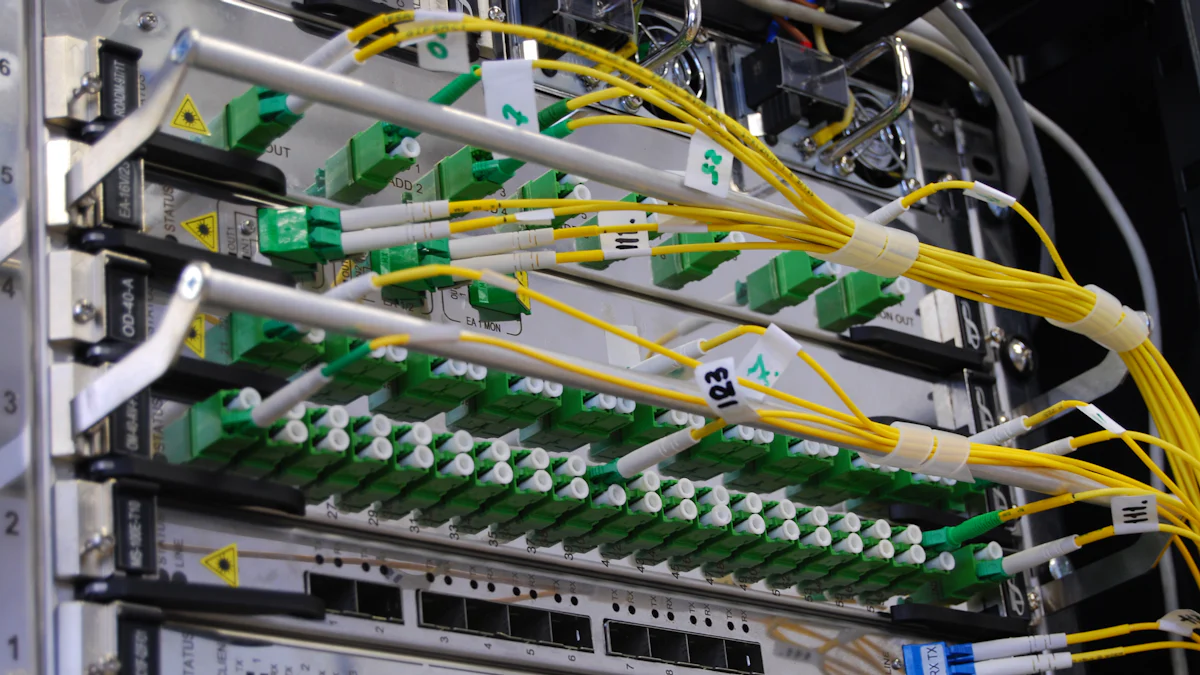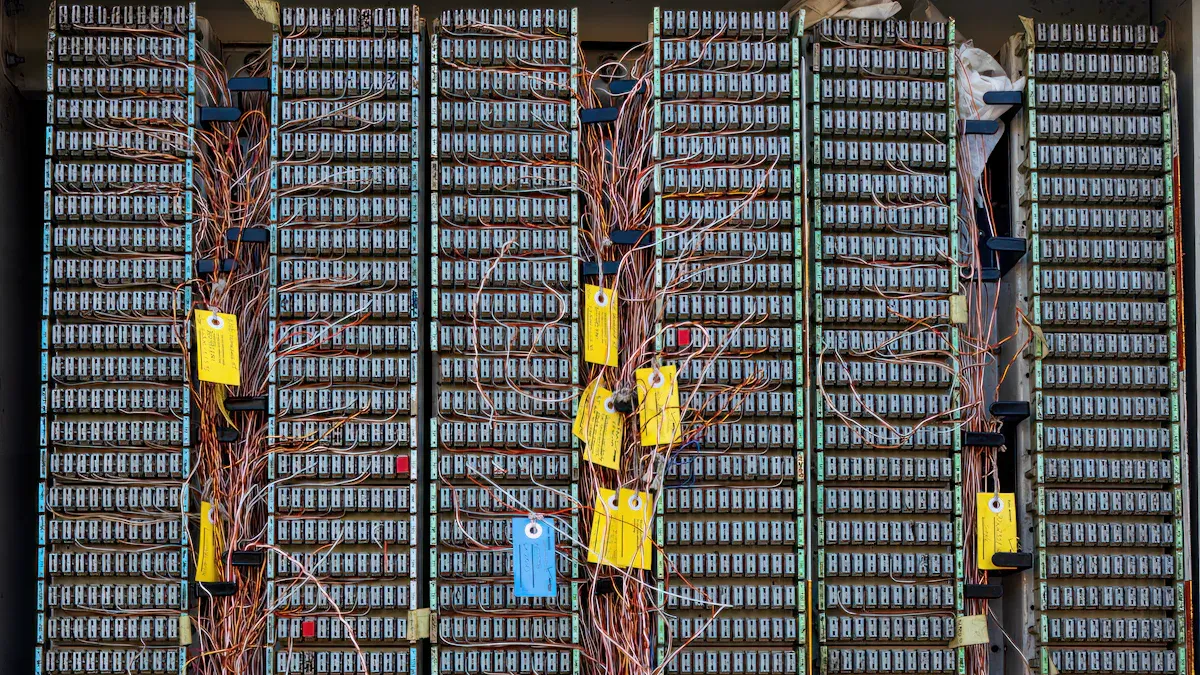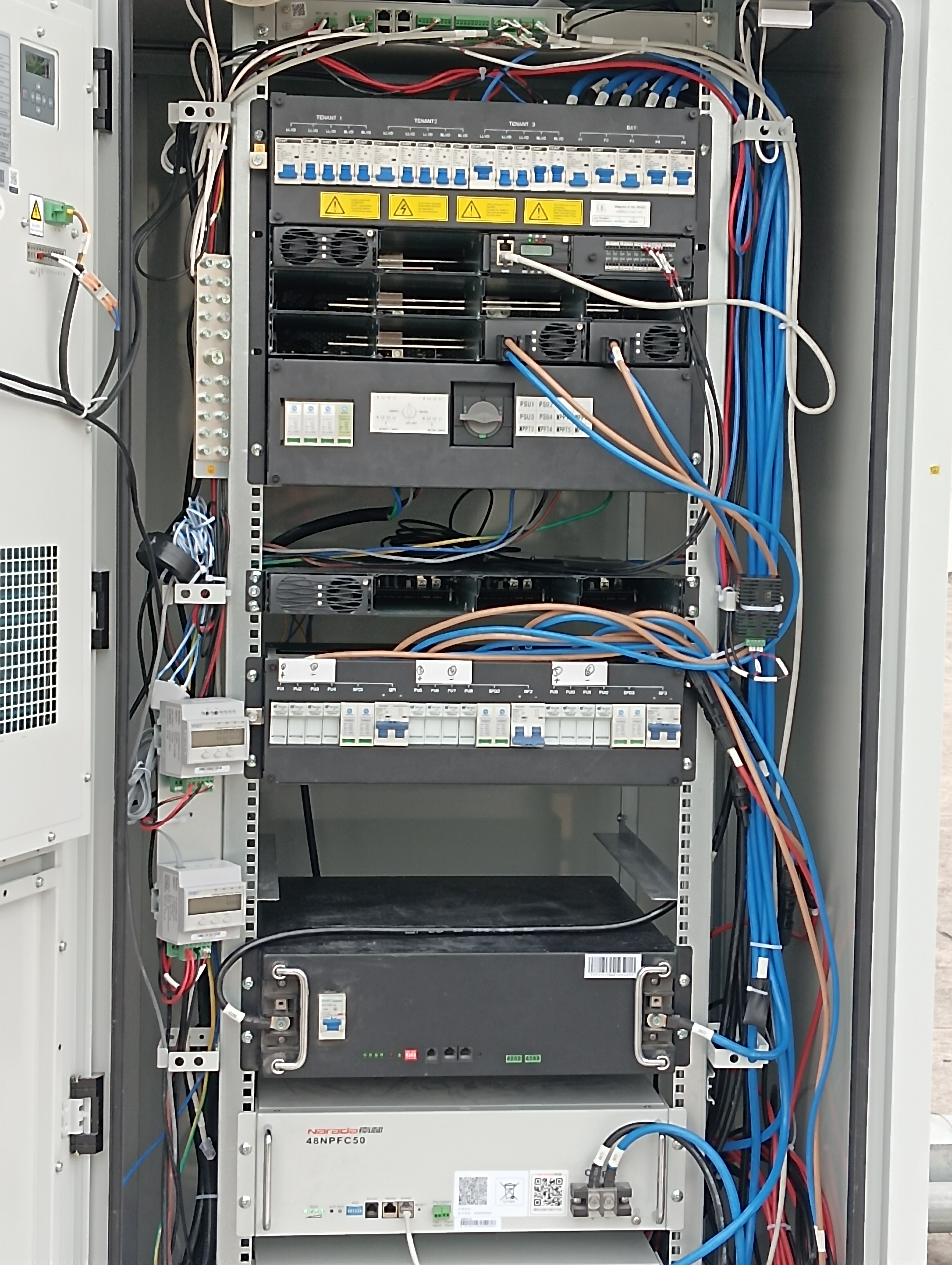What Are ESTEL Telecom Rectifier Modules and How Do They Work

Telecom rectifier modules play a crucial role in powering modern communication networks. These devices convert AC power into DC power, providing the stable energy required for seamless telecom operations. Without them, maintaining reliable and efficient telecom infrastructure would be challenging. As data services expand globally, efficient power conversion systems reduce energy losses and operational costs. They also support the shift toward renewable energy, helping telecom operators meet sustainability goals. By ensuring consistent power delivery, these modules enhance network reliability and performance, making them indispensable for the telecom industry.
Key Takeaways
Telecom rectifier modules change AC power into DC power. This provides steady energy for telecom devices.
These modules work efficiently, wasting less energy and saving money. They also help protect the environment.
Their modular design makes it easy to add more power as networks grow. This lowers costs and makes repairs simpler.
Advanced features let users manage power systems remotely. This improves how well the systems work and keeps them reliable.
They can work with renewable energy sources. This helps telecom companies stay eco-friendly while keeping networks strong.
Understanding Telecom Rectifier Modules

What Are Telecom Rectifier Modules
Telecom rectifier modules are specialized devices designed to convert alternating current (AC) into direct current (DC). This conversion is essential for powering telecommunications equipment, which relies on a stable DC supply to function effectively. These modules form the backbone of telecom power systems, ensuring uninterrupted operation of critical infrastructure like base stations, data centers, and network hubs.
At their core, telecom rectifiers consist of several key components that work together to deliver reliable power. These include:
Rectifier Stage: Converts AC electricity into DC.
DC-to-DC Converter: Regulates the DC voltage to meet the specific requirements of telecom equipment, typically 48V DC.
Battery Backup System: Provides continuous power during outages, ensuring network uptime.
EMI Filter: Reduces electromagnetic interference, maintaining stable operation of connected devices.
These features make telecom rectifier modules indispensable for modern communication networks. Their modular and scalable design allows you to expand power systems as your network grows, while advanced protection features safeguard against overvoltage, overcurrent, and overheating. Additionally, remote monitoring capabilities enable you to manage power systems efficiently, even from a distance.
Core Functionality of Rectifier Modules
The primary function of rectifier modules is to convert AC power into DC power. This process is critical because most telecom equipment operates on DC electricity. By eliminating fluctuations in AC power, rectifier modules provide a stable and constant DC supply. This stability enhances the performance of connected devices and extends their lifespan by reducing the risk of voltage spikes.
Modern telecom rectifiers incorporate advancements in rectifier module technology, such as active power factor correction and intelligent monitoring systems. These innovations optimize the power conversion process, ensuring high efficiency and reliability. For example, ESTEL’s Delta Rectifier Modules achieve a conversion efficiency of over 98%, outperforming competitors’ modules, which typically range from 94% to 96%. This high efficiency minimizes energy wastage and reduces operating costs, making them an ideal choice for telecom operators.
Feature | ESTEL’s Delta Rectifier Modules | Competitors’ Modules |
|---|---|---|
Modularity | Ultra-modular designs | Limited modular options |
AI Integration | Predictive analytics & self-optimization | Basic AI capabilities |
Conversion Efficiency | >98% | 94–96% |
Applications | Automotive, hybrid vehicles, industrial automation solutions | Primarily automotive |
In addition to power conversion, rectifier modules play a vital role in voltage regulation. The DC-to-DC converter ensures that the output voltage remains within the required range, even when input voltage fluctuates. This feature is particularly important in regions with unstable power grids. Furthermore, the inclusion of battery backup systems ensures that your telecom network remains operational during power outages, maintaining network stability and uptime.
By integrating these functionalities, telecom rectifier modules not only support the operation of telecommunications infrastructure but also contribute to energy efficiency and sustainability. Their ability to adapt to renewable energy sources, such as solar and wind, further underscores their importance in modern telecom systems.
How Telecom Rectifier Modules Work
The AC to DC Power Conversion Process
Telecom rectifier modules are designed to convert AC voltage to DC voltage, a process essential for powering telecom equipment. The conversion begins with the rectifier stage, where alternating current is transformed into direct current using high-speed diodes. These diodes minimize energy losses during rectification, ensuring efficient energy conversion. Robust transformers stabilize voltage levels, preventing fluctuations that could disrupt telecom operations.
The process flow can be summarized in the following table:
Specification | Value |
|---|---|
DC Output Voltage | 48 volts |
DC Output Current | 20 A |
AC Input Voltage | 90 volts |
Maximum Rated AC Current | 13.55/6.33 A |
Efficiency | Up to 96% |
Operating Temperature Range | -40°C to +65°C |
Compliance | NEBS Level 3, CSA/UL Recognized, VDE Certified, GR-3108 compliant, CE Mark for Low Voltage Directive |
Advanced materials like silicon carbide (SiC) and gallium nitride (GaN) further enhance the efficiency and thermal performance of telecom rectifiers. These innovations ensure that the modules operate reliably under varying load conditions. Testing efficiency is crucial to verify optimal performance. Engineers measure the conversion rate of AC to DC power using power analyzers, ensuring high efficiency—often exceeding 96%. This minimizes energy losses and supports the continuous operation of telecom systems.
Voltage Regulation and Power Stabilization
Voltage regulation is a critical function of telecom rectifier modules. The DC-to-DC converter within the module ensures that the output voltage remains stable, even when the input voltage fluctuates. This stability is vital for telecom equipment, which requires a consistent power supply to function effectively. Without proper regulation, voltage spikes could damage sensitive components, leading to costly repairs and downtime.
Modern telecom rectifiers incorporate synchronous rectification techniques to enhance power quality. By using MOSFETs, these systems reduce conduction losses and improve reliability. Compliance with global energy standards further ensures that telecom rectifiers meet stringent requirements for efficiency and sustainability. For example, ESTEL’s class 4 telecom rectifiers adhere to NEBS Level 3 and CE Mark standards, guaranteeing high reliability in high-power applications.
Case studies highlight the effectiveness of these systems. GreenConnect, a telecom operator, implemented ESTEL’s high-efficiency rectifiers at 500 remote sites. The results were remarkable: energy use dropped by 30%, CO2 emissions decreased by 40%, and downtime was reduced by 25%. These outcomes demonstrate the importance of voltage regulation and stabilization in achieving operational efficiency and sustainability.
Energy Efficiency in Telecom Rectifiers
Energy efficiency is a cornerstone of modern telecom rectifiers. High efficiency reduces energy waste, lowers operational costs, and supports environmental sustainability. Telecom rectifier modules achieve this through advanced power conversion techniques and intelligent monitoring systems. For instance, ESTEL’s rectifiers boast conversion efficiencies exceeding 95%, setting benchmarks for the industry.
The following table illustrates efficiency benchmarks:
Efficiency Benchmark | Description |
|---|---|
Conversion Efficiency | Modern rectifiers achieve efficiencies exceeding 95%. |
Synchronous Rectification | Uses MOSFETs to lower conduction losses and enhance reliability. |
Compliance with Energy Standards | Adheres to global energy standards for improved sustainability. |
Efficient energy conversion is particularly important in high-power applications, such as base stations and data centers. By minimizing energy losses, telecom rectifiers contribute to significant yearly energy savings—often around 5%. This not only reduces costs but also aligns with sustainability goals, making them indispensable for telecom operators.
Key Features of ESTEL Telecom Rectifier Modules
Modularity and Scalability
ESTEL telecom rectifier modules are designed with modularity in mind, allowing you to expand your power systems as your network grows. Each module operates independently, making it easy to add or replace units without disrupting the entire system. This flexibility ensures that your infrastructure can adapt to increasing power demands, whether you're scaling up a data center or deploying new base stations.
Scalability also reduces costs by letting you invest in additional modules only when needed. For example, if your telecom network expands into remote areas, you can integrate more rectifiers seamlessly. This modular approach not only saves money but also simplifies maintenance, as faulty modules can be replaced individually without affecting the overall performance.
Advanced Monitoring and Control Systems
Modern ESTEL rectifier modules come equipped with advanced monitoring and control systems. These systems allow you to track performance metrics, such as voltage levels, current output, and temperature, in real time. Remote monitoring capabilities enable you to manage your power systems from anywhere, reducing the need for on-site inspections.
Intelligent control features, like load balancing and fault detection, further enhance operational efficiency. Load balancing ensures that power is distributed evenly across all modules, preventing overloading and extending the lifespan of your equipment. Fault detection systems identify issues early, minimizing downtime and ensuring a reliable power supply for your telecom infrastructure.
High Reliability and Durability
Reliability and durability are hallmarks of ESTEL rectifier modules. These modules undergo rigorous testing to meet global standards, ensuring consistent performance even in harsh environments. Built with durable materials, they can withstand extreme conditions, including high temperatures and humidity.
Key reliability features include:
Intelligent load balancing to reduce wear and tear.
Fault-tolerant designs that minimize downtime.
High efficiency levels, often exceeding 95%, to reduce energy losses.
These rectifiers are engineered to provide a reliable power supply, making them ideal for critical telecom applications. Their robust construction and advanced features ensure long-term performance, giving you peace of mind as you manage your network.
Applications of Rectifier Modules in Telecommunications

Powering Telecom Networks and Base Stations
Rectifier modules play a vital role in powering telecom networks and base stations. These systems require a stable DC power supply to ensure uninterrupted operations. By converting AC power into DC, rectifier modules provide the reliable energy needed for critical communication systems. Their advanced protection mechanisms safeguard telecom infrastructure from voltage fluctuations, ensuring stable electrical operations even in challenging environments.
The efficiency and adaptability of rectifier modules make them indispensable for telecommunication networks. For instance, ESTEL rectifiers operate efficiently across a wide temperature range, from -25°C to +55°C. They also feature remote monitoring capabilities, allowing you to track performance metrics in real time. This ensures optimal energy efficiency and reduces the risk of downtime. The table below highlights key features that support their application in telecom networks:
Feature | Details |
|---|---|
Efficiency Rating | Above 95% |
Operating Temperature Range | -25°C to +55°C |
Advanced Protection Mechanisms | Safeguards against voltage fluctuations |
Remote Monitoring Capability | Allows real-time performance tracking |
Application Areas | Cellular networks, data centers, remote locations |
These features demonstrate how rectifier modules enhance the reliability and scalability of telecom infrastructure, making them essential for powering base stations and network hubs.
Ensuring Network Stability and Uptime
Maintaining network stability and uptime is crucial for telecom operators. Rectifier modules contribute to this by providing redundancy and backup power during outages. Their integration with battery systems ensures that critical communication systems remain operational, even when the primary power source fails. This redundancy minimizes disruptions and protects sensitive telecom equipment from damage caused by power interruptions.
Modern rectifiers also incorporate intelligent load balancing, distributing power evenly across modules. This prevents overloading and extends the lifespan of your telecom infrastructure. By stabilizing voltage levels, rectifier modules reduce the risk of equipment failure, ensuring consistent performance. Their ability to adapt to fluctuating power inputs further enhances network reliability, especially in regions with unstable grids.
Supporting Renewable Energy Integration
The shift toward renewable energy has created new opportunities for telecom operators to reduce their carbon footprint. Rectifier modules support this transition by stabilizing power delivery from renewable sources like solar and wind. These modules handle variable inputs efficiently, ensuring consistent energy output during fluctuations. This capability is critical for maintaining stable electrical operations in hybrid energy systems.
ESTEL rectifiers integrate seamlessly with advanced energy storage solutions, contributing to grid stability. Their design supports optimal energy efficiency, enabling telecom infrastructure to operate sustainably. The table below illustrates the benefits of rectifier modules in renewable energy integration:
Evidence Description | Benefit of Rectifier Modules in Renewable Energy Integration |
|---|---|
ESTEL rectifiers are designed to handle variable inputs from renewable sources. | They stabilize power delivery, ensuring consistent energy output during fluctuations. |
Integration with advanced energy storage solutions contributes to grid stability. | Supports efficient management of energy resources in hybrid energy systems. |
By leveraging these capabilities, rectifier modules help telecom operators achieve sustainability goals while maintaining reliable network performance.
ESTEL telecom rectifier modules provide the reliable power conversion you need to maintain modern telecom systems. Their advanced features, such as modularity and scalability, allow you to adapt your infrastructure as your network grows.
📌 Key Takeaway: These modules not only ensure stable power delivery but also improve energy efficiency, helping you reduce operational costs and meet sustainability goals.
By integrating ESTEL rectifiers into your telecom infrastructure, you can enhance network performance and ensure long-term reliability. Their innovative design makes them an essential tool for powering the future of telecommunications.
FAQ
What makes ESTEL telecom rectifier modules different from other brands?
ESTEL modules offer superior efficiency, modularity, and advanced monitoring features. Their conversion efficiency exceeds 95%, reducing energy waste. You can scale systems easily and monitor performance remotely, ensuring reliability and adaptability for growing telecom networks.
Can ESTEL rectifier modules handle extreme environmental conditions?
Yes, ESTEL modules are built for durability. They operate reliably in temperatures ranging from -40°C to +65°C and withstand high humidity. Their robust design ensures consistent performance in harsh environments, making them ideal for remote or challenging locations.
How do ESTEL rectifier modules support renewable energy integration?
These modules stabilize power delivery from renewable sources like solar and wind. They efficiently manage variable inputs, ensuring consistent energy output. You can integrate them with energy storage systems to enhance sustainability and grid stability.
Are ESTEL rectifier modules easy to maintain?
Absolutely. Their modular design simplifies maintenance. You can replace faulty modules individually without disrupting the system. Remote monitoring features also allow you to identify issues early, reducing downtime and maintenance costs.
Do ESTEL rectifier modules comply with global standards?
Yes, ESTEL modules meet stringent global standards like NEBS Level 3 and CE Mark certifications. These ensure high reliability, energy efficiency, and safety, making them suitable for critical telecom applications worldwide.
See Also
Understanding the ESTEL Power System for Telecom Cabinets
Exploring Energy Storage Solutions for ESTEL Telecom Cabinets
Ensuring Optimal Voltage in ESTEL Communication Cabinets
Integrating Smart Microgrid with ESTEL Telecom Energy Storage
Calculating Power Systems and Batteries for Telecom Cabinets
CALL US DIRECTLY
86-13752765943
3A-8, SHUIWAN 1979 SQUARE (PHASE II), NO.111, TAIZI ROAD,SHUIWAN COMMUNITY, ZHAOSHANG STREET, NANSHAN DISTRICT, SHENZHEN, GUANGDONG, CHINA


